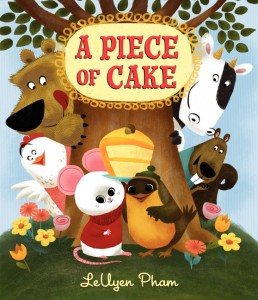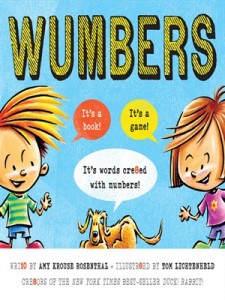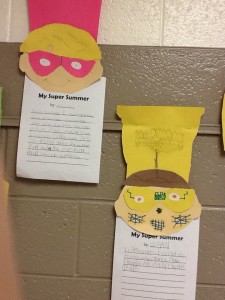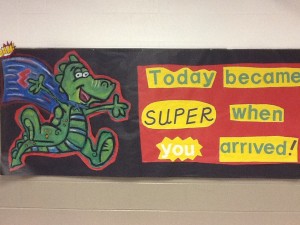A Piece of Cake
 Every December I see lists of the best books of the year, and every year there’s at least one gem that I can’t believe isn’t getting more love. My choice this year for the “Don’t Miss This Picture Book” award is A Piece of Cake by LeUyen Pham (whose first name is pronounced “LeWin” but she mostly goes by “Win”. Now you know.)
Every December I see lists of the best books of the year, and every year there’s at least one gem that I can’t believe isn’t getting more love. My choice this year for the “Don’t Miss This Picture Book” award is A Piece of Cake by LeUyen Pham (whose first name is pronounced “LeWin” but she mostly goes by “Win”. Now you know.)
Pham had me from the moment she made the cover art reminiscent of a Golden Book, even down to her swirly signature. It starts like a sweet, simple story. A kind Mouse bakes a birthday cake for Little Bird, but then – there are all these unexpected surprises!
Mouse is bringing the cake to Little Bird’s house when Chicken stops him. Chicken wants a piece of cake, and the very kind Mouse has trouble saying no. Chicken, who is surrounded by eggs and is reading a book while sunning herself says, “If you give me a piece of that cake, I’ll trade you…” An egg, right? Nope! A cork, from Chicken’s bottle of suntan lotion.
At each stop on Mouse’s walk to and from Little Bird’s house, Pham sets us up to call out an obvious answer and then she delivers a twist that gets readers giggling. It reminds me of Guess Again by Mac Barnett and Adam Rex, but A Piece of Cake has a strong plot and internal logic as well as silly surprises. The cork that Chicken gave is used later for another unexpected purpose. It’s the ideal picture book to work on prediction and comprehension (Key Ideas and Details, anyone?)
Read this book aloud for the sheer pleasure of it, and then for the second reading, make a chart where kids can write what they thought would happen and what actually happened. “I thought Chicken would give Mouse ____ but then Chicken gave Mouse _________.” This is also a great story to act out for the whole group and then in centers so students can see what happens with each object. Make a Storybox with the characters and objects from the story for students to retell, and building comprehension skills will be A Piece of Cake.
Read More
Ten Rules of Being a Superhero
 I’ll bet you a sack of Halloween candy that most of us have dreamed of being a superhero: saving the day, maybe flying, definitely wearing a cool cape and a mask. Snazzy accessories aside, if you want to be a superhero, you need this book: Ten Rules of Being a Superhero by Deb Pilutti.
I’ll bet you a sack of Halloween candy that most of us have dreamed of being a superhero: saving the day, maybe flying, definitely wearing a cool cape and a mask. Snazzy accessories aside, if you want to be a superhero, you need this book: Ten Rules of Being a Superhero by Deb Pilutti.
Captain Magma and Lava Boy show us the rules with bright, captivating art and with short sentences to support younger readers. Big ideas like courage, integrity, and loyalty are introduced in kid-friendly ways, and there are good giggles, too. For example, Rule Number 2: “Saving the day is messy.” As Lava Boy cleans up the playroom ( with Captain Magma holding the dustpan), he adds, “Moms don’t understand Rule Number 2.”
There’s a fantastic, free discussion and activity guide (written by Superteacher Debbie Gonzales) that you can print from debpilutti.com. You’ll find fun games and a story sequencing activity that nails that Key Ideas & Details reading standard. I think Ten Rules of Being a Superhero makes a wonderful discussion and writing prompt. What are the qualities of a superhero? Who can be one? Since it’s October and many kids are thinking about costumes anyway, what about making superhero gear? Towels and blankets from the thrift store (thoroughly washed) can be made into capes. Donated t-shirts or paper grocery bags can be decorated with paints and markers.
One of my favorite elementary schools kicked off the year with this theme “Our School: Where Superheroes Are Made”. I’m sharing some photos that might inspire some super ideas. Read Ten Rules of Being a Superhero by Deb Pilutti to your students and watch how it pulls in your students like metal to Magneto.
Read MoreYou Can’t Ride a Bicycle to the Moon!
 Happy 2014! My goal this year is to share more nonfiction titles with you, so your Common Core Reading Standards Bingo Board will always have Range of Reading covered! I’m enjoying the new “You Can’t” series from Blue Apple books, especially You Can’t Ride a Bicycle to the Moon! by Harriet Ziefert and illustrated by Amanda Haley.
Happy 2014! My goal this year is to share more nonfiction titles with you, so your Common Core Reading Standards Bingo Board will always have Range of Reading covered! I’m enjoying the new “You Can’t” series from Blue Apple books, especially You Can’t Ride a Bicycle to the Moon! by Harriet Ziefert and illustrated by Amanda Haley.
This picture book has short chapters and all the informational text features we educators love, including informative illustrations with labels (why hello, Integrating Knowledge and Ideas!) Your students can use the fun space facts they learn from You Can’t Ride a Bicycle to the Moon! in a creative project that incorporates using labels on a diagram or picture as a part of informative writing.
After sharing the book, discuss as a class why you can’t ride a bicycle to the moon, and discuss the features a spaceship needs to support human life. Create a class-made checklist of spaceship essentials: food storage, sleeping area, etc. Students can design, draw, and write about their ideal spaceship. (If you are extra-crafty, get out the cardboard and glue along with the paper and markers to make the spaceship 3-D!) The spaceship should have everything inside that astronauts need to live, as well as something to make your spacecraft go. Encourage students to use labels on any illustrations to convey information as well as write a paragraph or two of explanatory text.
With interesting informational books like You Can’t Ride a Bicycle to the Moon!, all your students will be superstar readers!
For more information about the You Can’t series, please visit blueapplebooks.com.
Read More
Wumbers
 “What do you get when you combine a word with a number? A wumber!” Wumbers is wri10 by Amy Krouse Rosenthal and illustr8ed by Tom Lichtenheld, the dynamic duo who made Duck! Rabbit! and other books I love passion8ly. With Wumbers, kids have 2 pay at10tion to the sound of the number word to figure out how to read the wumber. 1ce your students get the gist of it, they’ll want 2 make up wumbers of their own!
“What do you get when you combine a word with a number? A wumber!” Wumbers is wri10 by Amy Krouse Rosenthal and illustr8ed by Tom Lichtenheld, the dynamic duo who made Duck! Rabbit! and other books I love passion8ly. With Wumbers, kids have 2 pay at10tion to the sound of the number word to figure out how to read the wumber. 1ce your students get the gist of it, they’ll want 2 make up wumbers of their own!
Because Wumbers focuses kids’ attention on the small sounds in words, it’s an ideal book to hit the CCSS of Phonological Awareness. Distinguishing the numbers from the letters in the words is part of Print Concepts. 1 book for 2 standards = gr8ful teacher and 4tunate students!
As you read Wumbers to your students, call at10tion first to the way the wumber looks. What number is mixed with letters to make a new word? 1ce students identify the number, say it out loud a few times, then blend the number name with the other letters slowly. Let kids have the thrill of calling out the wumber. It7ly! (Get it – it’s heavenly? Ok, I’m still working on a good one for 7.)
Before you let your students loose on reading and writing wumbers on their own, practice as a group. Choose a number, an easy one like 2 or 4 (because obviously 7 will pose challenges, even for those of us with plenty of wumber po10tial.) Write the number word and any phonological variations: 2 is two, to, too, tu, etc. Now, see if you can come up with words that have that to-tu sound in them. Tuba becomes 2ba. Toothbrush becomes a 2thbrush. Because she is genius, Amy Krouse Rosenthal has a free activities kit available through her website: whoisamy.com. If you and your students come up with some 1derful wumbers, email me! 2gether we will celebr8 Wumbers!
For more about the illustrator, please visit tomlichtenheld.com.
Read More









